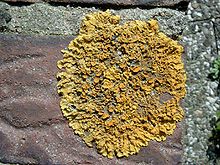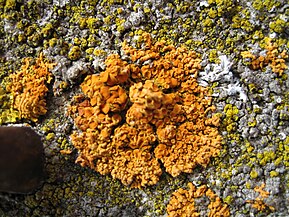Xanthoria parietina
| Xanthoria parietina | |
|---|---|

| |
| Scientific classification | |
| Domain: | Eukaryota |
| Kingdom: | Fungi |
| Division: | Ascomycota |
| Class: | Lecanoromycetes |
| Order: | Teloschistales |
| Family: | Teloschistaceae |
| Genus: | Xanthoria |
| Species: | X. parietina
|
| Binomial name | |
| Xanthoria parietina | |
| Synonyms[1] | |
| |
Xanthoria parietina is a foliose lichen in the family Teloschistaceae. It has wide distribution, and many common names such as common orange lichen, yellow scale,[2] maritime sunburst lichen and shore lichen. It can be found near the shore on rocks or walls (hence the epithet parietina meaning "on walls"),[3] and also on inland rocks, walls, or tree bark.[4] It was chosen as a model organism for genomic sequencing (planned in 2006) by the US Department of Energy Joint Genome Institute (JGI).



Taxonomy
The species was first scientifically described by Carl Linnaeus in 1753, as Lichen parietinus.
Xanthoria coomae, described from New South Wales in 2007, and Xanthoria polessica, described from Belarus in 2013, were later determined to be synonyms of Xanthoria parietina.[1]
Description
The
The outer "skin" of the lichen, the cortex, is composed of closely packed fungal hyphae and serves to protect the thallus from water loss due to evaporation as well as harmful effects of high levels of irradiation. In Xanthoria parietina, the thickness of the thalli is known to vary depending on the habitat in which it grows. Thalli are much thinner in shady locations than in those exposed to full sunshine; this has the effect of protecting the algae that cannot tolerate high light intensities. The lichen pigment parietin gives this species a deep yellow or orange-red color.[6]
Xanthoria parietina prefers growing on bark and wood; it is found more rarely on rock.[5] Nutrient enrichment by bird droppings enhances the ability of X. parietina to grow on rock.[7]
Photobiont
The photosynthetic symbionts, or photobionts, associated with X. parietina are from the green algal genus Trebouxia. Species that have been found include Trebouxia arboricola and T. irregularis.[8] Both of these photobionts are known to occur free-living in nature, having been found on bark colonized by X. parietina as well as on bark not colonized by lichens.[9]
In one study, the photobiont was shown to occupy 7% of the volume of the thallus.[10] The density of pigmentation of the upper cortex also varies and seems to control the amount of light reaching the algae.[10]
Reproduction and dispersal
A large number of lichens disperse very effectively by means of symbiotic vegetative propagules such as soredia, isidia and blastidia, and thallus fragmentation. However, X. parietina does not produce such vegetative propagules, but must establish the symbiotic state at each reproductive cycle. Two oribatid mite species, Trhypochtonius tectorum and Trichoribates trimaculatus, which are common inhabitants and consumers of X. parietina, are vectors of the photobiont cells. Faecal pellets of both species contain both viable ascospores and photobiont cells, and are suggested to be a common mode of short- and long-distance dispersal of this species.[11]
Habitat and distribution
Xanthoria parietina occurs in hardwood forests in broad, low-elevation valleys, as well as scattered on
The species is widespread, and has been reported from Australia, Africa, Asia, North America[16] and throughout much of Europe.[17] In eastern North America and Europe, it is found more frequently near coastal locations.[5] The increases in nitrate deposition as a result of industrial and agricultural developments in southern Ontario, Canada in the 20th century are thought to be responsible for the reappearance of this species in the local lichen flora.[18]
Pollution tolerance
Xanthoria parietina is a very pollution-tolerant species. In laboratory experiments, this species can tolerate exposure to air contaminants and bisulphite ions with little or no damaging effect.
For these reasons, this species has found use as a
Bioactive compounds

Xanthoria parietina produces an orange colored
Species interactions
The biochemical impacts of the lichenicolous fungus Xanthoriicola physciae on its host Xanthoria parietina were investigated using Raman spectroscopy. This technique revealed that the fungus destroys key photoprotective pigments such as parietin and carotenoids in the host, which are vital for protecting the lichen from intense sunlight. Additionally, the presence of scytonemin—a pigment typically produced by cyanobacteria and known for UV protection—was detected in the infected tissues, suggesting secondary colonisation by cyanobacteria.[27]
Research
The water extract of X. parietina has good antiviral activity
Gallery
-
Xanthoria parietina
-
Xanthoria parietina
-
X. parietina, close-up
-
Different colors from green to red
References
- ^ .
- ISBN 9780906720561.
- ^ "Charlton T. Lewis, Charles Short, A Latin Dictionary, părĭĕtārĭus". www.perseus.tufts.edu.
- ^ Paul, Heather; Knight, Sue. "Xanthoria parietina" (PDF). British Lichen Society. Retrieved 4 August 2022.
- ^ ISBN 978-0-87071-394-1.
- ISBN 978-0-8493-3581-5.
- .
- ISBN 978-0-471-57885-7.
- JSTOR 2432333.
- ^ ISBN 978-0-7131-2457-6.
- .
- S2CID 86013611.
- S2CID 85721871.
- PMID 16777293.
- S2CID 84672072.
- ^ Hogan, C. Michael. 2008. Black Spruce: Picea mariana, GlobalTwitcher.com, ed. Nicklas Stromberg Archived October 5, 2011, at the Wayback Machine
- ISBN 978-91-628-2777-9.
- S2CID 84646971.
- S2CID 86012279.
- S2CID 42330557.
- PMID 24485905.
- PMID 17716704.
- S2CID 94574341.
- .
- .
- PMID 11082848.
- hdl:10454/10042.
- ^ Karagoz, Ali; Doğruöz Güngör, Nihal; Zeybek, Zuhal; Aslan, Ali (December 2014). "Antibacterial activity of some lichen extracts". Journal of Medicinal Plant Research. 60 (3): 281–6.
- ISBN 978-0-12-044950-7.
External links
 Media related to Xanthoria parietina at Wikimedia Commons
Media related to Xanthoria parietina at Wikimedia Commons- Radoslaw Walkowiak, Akira Takeuchi, Short Note of Xanthoria parietina, CTC PAPER 2020
- http://www.jgi.doe.gov/sequencing/why/CSP2006/Xparietina.html
- http://www.nhm.ac.uk/nature-online/species-of-the-day/biodiversity/climate-change/xanthoria-parietina/index.html




